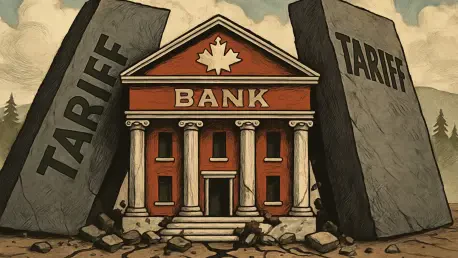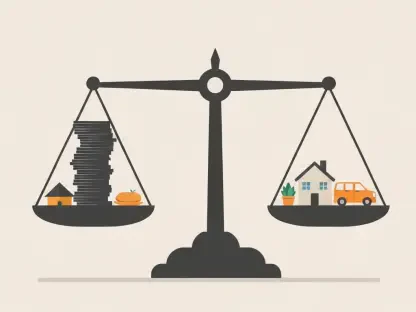Imagine a financial landscape where the specter of trade wars looms large, threatening to disrupt the stability of an entire banking sector. For Canadian banks, the third quarter has been a critical test of resilience amid fears of U.S. tariffs impacting their loan portfolios and overall economic health. With trade dynamics under the Canada-United States-Mexico Agreement (CUSMA) shaping much of the narrative, this roundup dives into diverse perspectives from industry analysts and financial experts. The purpose is to explore how these institutions are navigating tariff challenges, adapting strategies, and maintaining stability in a complex economic environment.
Understanding the Tariff Terrain and Its Effects on Banking
The current trade environment, governed by CUSMA, has been a double-edged sword for Canadian banks. While 92% of Canadian exports entered the U.S. tariff-free in June, the initial threat of retaliatory tariffs sparked widespread concern among financial leaders. Analysts note that early fears of a full-blown trade conflict prompted banks to bolster loan-loss provisions over recent quarters, preparing for potential defaults tied to disrupted trade flows.
However, a shift in policy dynamics has offered some relief. Recent moves to de-escalate tensions, including adjustments in retaliatory measures, have eased the immediate pressure on the banking sector. Industry observers highlight that this evolving landscape has allowed banks to reassess their risk exposure, creating a more optimistic outlook for Q3 performance compared to earlier projections.
This unexpected turn has sparked varied opinions on the long-term implications. Some financial strategists argue that while the current stability is encouraging, the underlying uncertainty of trade relations remains a concern. They emphasize the importance of continuously monitoring policy changes to anticipate any sudden shifts that could reignite economic stress for these institutions.
Strategic Responses and Performance Insights for Q3
Reducing the Weight of Loan-Loss Provisions
One of the most discussed topics among banking analysts is the significant decline in loan-loss provisions, dropping to C$5.22 billion in Q3 from C$6.37 billion in the previous quarter. This reduction signals a milder impact from tariff concerns than initially anticipated, reflecting a more stable trade environment under CUSMA. Many experts view this as a positive indicator of the banks’ ability to adapt to external pressures.
Insights from industry reports suggest that the high percentage of tariff-free exports, combined with strategic policy adjustments, has lowered fears of widespread loan defaults. Analysts from various financial firms point out that this has allowed banks to redirect resources previously set aside for risk management toward other growth initiatives, though opinions differ on the permanence of this trend.
A note of caution persists among some market watchers who question whether this decrease in provisions represents a sustainable shift. They argue that lingering economic uncertainties could still pose risks, urging stakeholders to remain vigilant. This diversity in viewpoints underscores the complexity of predicting future stability in such a fluid geopolitical context.
Driving Revenue Despite Stagnant Loan Growth
On the revenue front, Canadian banks have shown promising growth in net interest income, with projections ranging from 9.3% to 57%. This uptick, driven by the margin between loan earnings and deposit costs, has been a focal point for financial commentators. Many agree that this financial boost provides a critical buffer against the sluggish loan demand observed in a saturated domestic market.
Beyond interest income, experts highlight the growing role of capital markets and wealth management as key contributors to fee-based revenue. These segments are seen as vital for offsetting the challenges of limited loan growth, with several analysts praising the banks’ pivot to diversified income streams as a smart adaptation to current market conditions.
Yet, there is no unanimous agreement on the risks tied to this strategy. Some industry voices express concern over an over-reliance on alternative revenue sources, warning that sustained economic uncertainty could dampen these gains. They stress the need for banks to explore innovative ways to stimulate loan demand while balancing these newer income channels.
Building Capital Strength and Exploring New Markets
The robust capitalization of Canadian banks has been a recurring theme in expert discussions, with many noting the accumulation of excess capital amid limited domestic investment opportunities. This financial strength is viewed as a cornerstone of resilience, providing a safety net against potential tariff-related disruptions or other economic headwinds.
Expansion into the U.S. market and increased focus on wealth management are frequently cited as strategic moves to counter domestic constraints. Analysts from multiple financial advisory groups see these initiatives as essential for long-term growth, though they acknowledge the challenges of navigating regulatory landscapes and market competition abroad.
Differing perspectives emerge on the sustainability of these international ventures. While some experts are optimistic about the potential for significant returns, others caution that unforeseen barriers could hinder success. This split in opinion reflects the broader uncertainty surrounding global expansion as a solution to domestic limitations.
Prioritizing Resilience Through Capital Deployment
Stock buybacks, totaling around C$4 billion in Q3, have emerged as a popular method for returning value to shareholders, according to various financial reviews. This approach is often interpreted as a signal of confidence in the banks’ capital positions, though it also highlights the struggle to find productive domestic investment avenues.
Analyst insights vary on how management should deploy capital to meet medium-term goals. Some advocate for a conservative approach, maintaining strong reserves to weather future uncertainties, while others push for bolder investments in technology or new markets. This debate illustrates the delicate balance between rewarding investors and preparing for potential challenges.
Speculation abounds on alternative uses of capital, with suggestions ranging from digital innovation to strategic acquisitions. Industry thought leaders emphasize the need for creative solutions to ensure that excess funds are utilized effectively, adding a forward-looking dimension to the conversation around tariff challenges and economic adaptation.
Key Takeaways from Q3 Performance Discussions
Synthesizing the array of opinions, several core themes stand out: the notable reduction in loan-loss provisions reflects a dodged worst-case tariff scenario, while growth in diversified income sources like net interest and fee-based revenue underscores underlying strength. Strategic moves toward international markets are also widely discussed as a response to domestic growth constraints.
For stakeholders, actionable advice includes keeping a close eye on trade policy developments that could influence banking stability. Exploring wealth management as a potential investment area is another recommendation echoed by many analysts, given its proven capacity to generate steady returns in uncertain times.
Staying informed on upcoming earnings reports, particularly from major players like Bank of Montreal and Bank of Nova Scotia, is also advised. These disclosures will offer critical insights into how well the sector continues to adapt, providing a benchmark for assessing ongoing resilience against tariff and economic pressures.
Reflecting on a Quarter of Adaptation
Looking back, the third quarter proved to be a pivotal period for Canadian banks as they navigated the turbulent waters of tariff uncertainties with a blend of caution and strategic innovation. The collective insights from analysts paint a picture of cautious optimism, tempered by the recognition of persistent domestic challenges.
Moving forward, the focus should shift to actionable strategies such as fostering partnerships for international growth and investing in technology to enhance operational efficiency. Exploring untapped domestic niches could also offer a complementary path to bolster loan growth. As the banking sector continues to adapt, stakeholders are encouraged to delve deeper into industry reports and trade policy updates to anticipate the next set of challenges and opportunities on the horizon.









